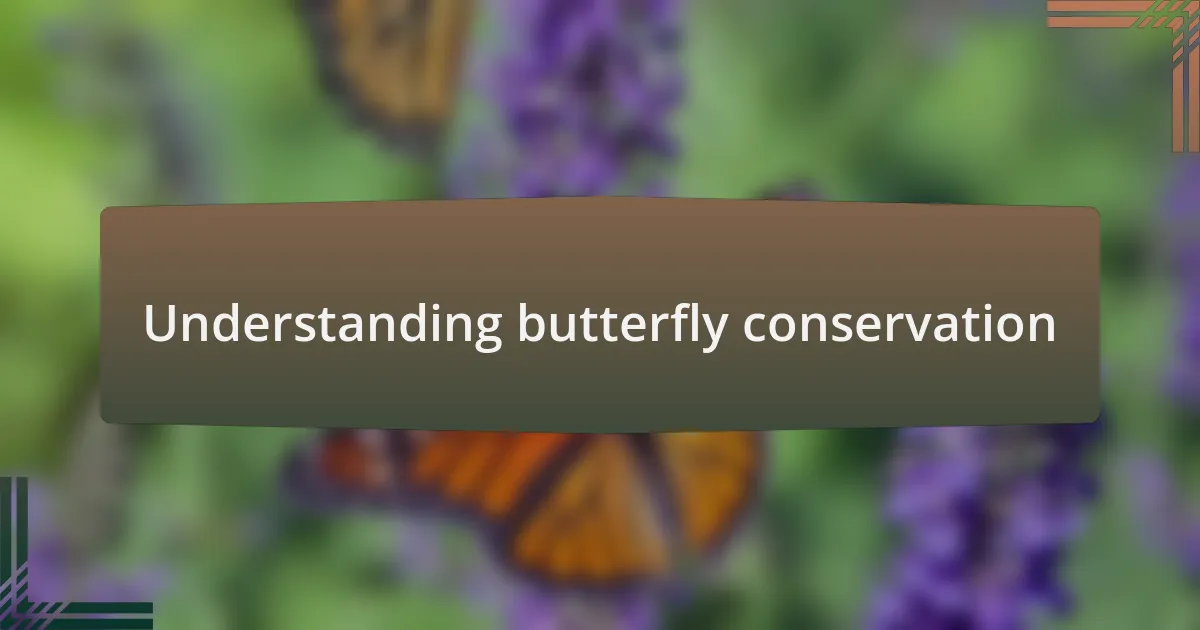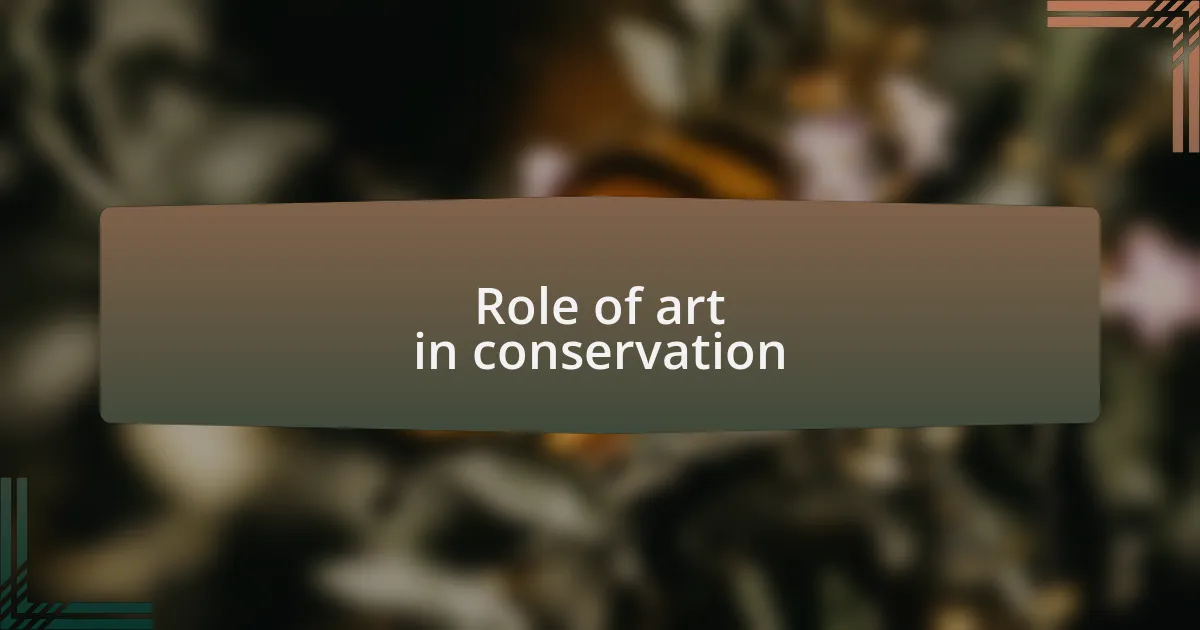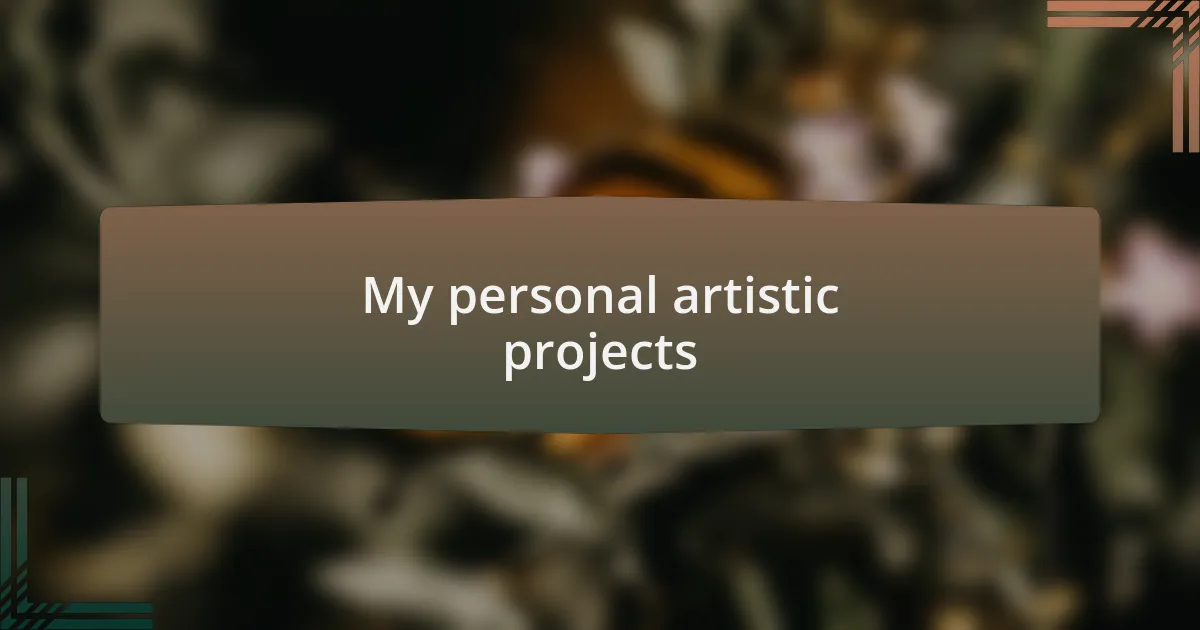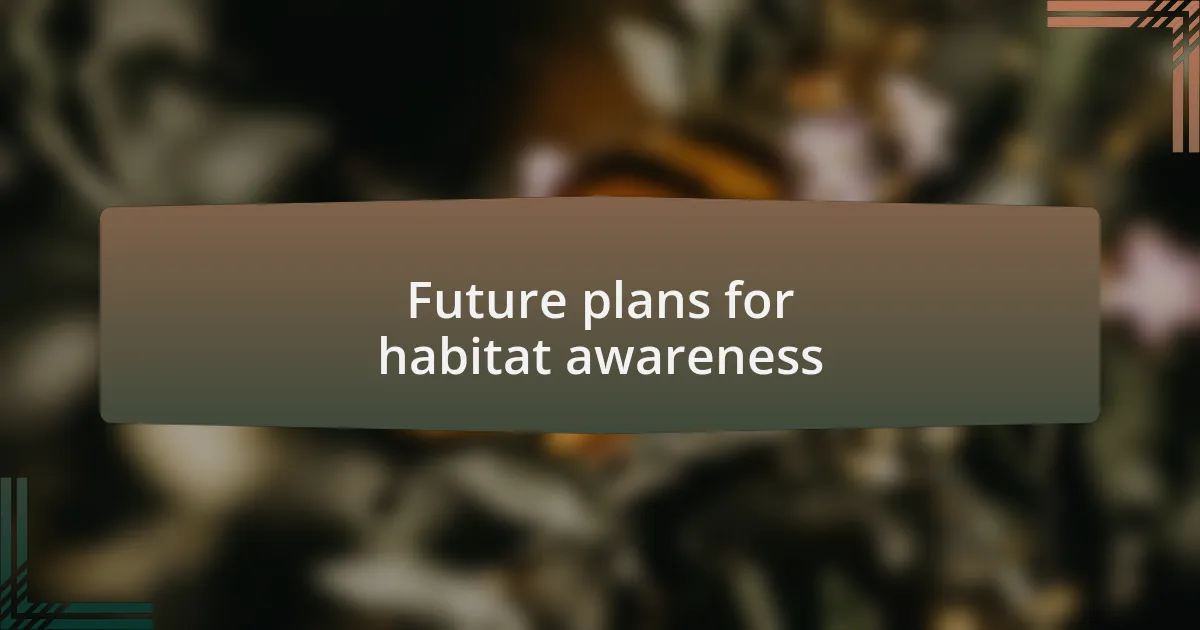Key takeaways:
- Butterfly conservation is essential for ecosystem health and involves understanding the specific habitat needs of butterflies.
- Art can effectively raise awareness about conservation by bridging emotions with education, inspiring community action and dialogue.
- Community involvement, such as cleanup events and educational workshops, fosters a deeper appreciation for habitats and encourages stewardship.
- Future initiatives aim to use art and digital storytelling to further engage the community in protecting local ecosystems and promoting habitat awareness.

Understanding butterfly conservation
Butterfly conservation is not just about protecting butterflies; it’s about preserving entire ecosystems that depend on them. I recall a time when I visited a local butterfly garden, only to witness firsthand how these delicate creatures pollinate plants, which in turn support various wildlife. Can you imagine a world without the vibrant flutter of wings or the colorful flowers that rely on these pollinators?
Understanding the intricate relationship between butterflies and their habitats is crucial. When I learned that the loss of wildflowers directly impacts butterfly populations, it struck me how interconnected everything is. Each butterfly species has specific needs, from particular host plants for larval stages to the right conditions for adults. How often do we take a moment to think about what these beautiful insects require to thrive?
Conservation efforts also involve raising awareness about the challenges they face, such as habitat destruction and climate change. I remember a community workshop where we painted butterfly murals, and through this art, participants expressed their fears regarding these threats. Isn’t it fascinating how art can capture emotions and spark conversations about critical issues like conservation? It’s a reminder that every action we take, whether big or small, can make a difference.

Importance of habitat awareness
Awareness of habitats is vital for fostering a sense of responsibility towards the environment. I remember sitting in a local park, watching children chase butterflies. It struck me that if they understood the butterflies’ role in our ecosystem, they would appreciate their beauty even more. How can we expect future generations to care if they’re unaware of what holds everything together?
Moreover, the decline of butterfly populations mirrors the health of our environment. I often reflect on how my own garden has changed over the years. Once filled with diverse flora that attracted a myriad of butterflies, it has seen a reduction in species due to urban development. Isn’t it sobering to consider that our choices directly impact the habitats we cherish?
Fostering habitat awareness can ignite action. During a recent art exhibit, I displayed works that highlighted the importance of native plants in supporting butterfly life cycles. Seeing people’s reactions, I realized that art has the power to evoke emotions and inspire change. When we connect deeply with nature’s stories, we might just find the motivation to protect the delicate balance of our ecosystems.

Role of art in conservation
Art plays a transformative role in conservation by bridging the gap between emotion and education. I recall a time when I visited an art installation made entirely of recycled materials, symbolizing the fragility of our ecosystems. It left me pondering: How can something so beautiful also serve as a stark reminder of what we stand to lose? This connection ignites a passion for protecting our natural world.
Moreover, art can serve as a powerful tool for storytelling in conservation. At one exhibit, I featured paintings that depicted the lifecycle of butterflies in various habitats. I watched as viewers were drawn in, their expressions shifting from curiosity to concern. Isn’t it fascinating how a vivid portrayal of these creatures can evoke such a strong emotional response and spark conversations about their preservation?
Finally, collaborating with artists can amplify our conservation messages. I once teamed up with a local painter who immersed himself in a butterfly-rich environment for inspiration. His final piece encapsulated the beauty of a thriving habitat, and we used it for educational campaigns. It made me realize, how often do we overlook the potential of art to inspire collective action in protecting what we love?

Artistic methods for promoting awareness
Creating interactive art installations is one effective method for promoting habitat awareness. I remember walking through a community garden where a local artist had turned native plants into a colorful mural. Each plant was labeled with its significance to local wildlife, and while engaging with the visuals, I noticed families discussing the impact of these plants on butterfly populations. Have you ever witnessed how an engaging visual can spark meaningful dialogue?
Another powerful approach is hosting workshops that involve creating art from nature. I participated in an event where we crafted sculptures using natural materials found nearby. The hands-on experience deepened my appreciation for our local ecosystem and offered a tangible way to connect with the habitat. This method not only fosters creativity but also instills a sense of responsibility towards nature. How often do we get the chance to merge art with ecological stewardship in such immersive ways?
Digital art forms, like virtual galleries or interactive online platforms, can also captivate young audiences. During a recent online exhibition, I watched as children animated their own butterfly stories using digital tools. Their excitement was palpable; they were not just creating art, but also learning about species and habitats. It made me reflect: could embracing technology be the key to reaching a new generation of conservation advocates?

My personal artistic projects
My personal artistic projects often revolve around the beauty and fragility of habitats. A few years ago, I created a series of paintings that depicted local butterfly species amidst their natural environments. As I painted, I felt a deep connection to the butterflies fluttering outside my window, and each stroke reminded me of their delicate role in the ecosystem. What if art could not only capture beauty but also shed light on their peril?
One project that stands out was a community mural focusing on native pollinators. I invited local residents to join me, and we painted blossoms and the butterflies they attract. Watching the community come together, bonding over shared brushes and laughter, was a heartwarming experience. This collaborative approach left me pondering: how can collective creativity enhance our understanding of nature?
Another endeavor I embarked on was creating handmade journals filled with sketches of different habitats and the species that inhabit them. As I filled each page with illustrations, I found solace in the process, expressing not just the beauty I saw but also the urgency of conservation efforts. Those journals serve as a reminder of the stories these species tell, urging us to listen closely. Can sharing these visual narratives inspire others in their own conservation journeys?

Community involvement in habitat protection
Engaging the community in habitat protection can be a powerful way to foster awareness and inspire change. When I organized a cleanup day at a local butterfly reserve, I was struck by the enthusiasm of families coming together to pick up litter. Their commitment not only revitalized the area but also sparked genuine conversations about the importance of maintaining healthy ecosystems. Wouldn’t it be wonderful if everyone realized that small actions could lead to significant environmental impacts?
Another heartwarming experience for me was hosting art workshops in schools, where children created their interpretations of local habitats. Seeing their eyes light up as they explored the colors and textures of nature was incredible. These sessions often ended with the kids asking how they could help butterflies and their habitats survive. It made me wonder: What if we could turn that curiosity into lifelong stewardship?
Community gardens can also play a vital role in habitat protection. I remember volunteering at one where we focused on planting native species that attract pollinators. Not only did we create a thriving habitat, but the sense of pride among the participants was palpable. It’s fascinating how such projects can transform individuals into advocates for nature, isn’t it? By nurturing our environment, we nurture our community spirit too.

Future plans for habitat awareness
Looking ahead, I envision expanding our art-based initiatives to include mural projects in public spaces, where residents can visually celebrate local ecosystems. I believe that when a community sees its habitat depicted artistically, it can create a deeper sense of ownership and a willingness to protect those spaces. Imagine walking by a vibrant mural that reminds you of the beauty and fragility of butterfly habitats. Isn’t it inspiring to think about how art could transform our everyday environments?
I also plan to collaborate with local artists to create interactive installations that encourage passersby to engage with the themes of conservation and habitat awareness. For instance, a sculptural piece made from recycled materials could spark conversations about pollution and its impact on our butterflies. This kind of art can make abstract issues feel more tangible, don’t you think? I’ve seen firsthand how a provocative piece can linger in someone’s mind long after they’ve left the exhibition.
Furthermore, I intend to develop a digital storytelling campaign that highlights individuals’ efforts to protect their local habitats. By sharing personal stories through social media platforms, I hope to foster a broader conversation about conservation challenges and achievements. After all, who doesn’t love a good story? Our combined narratives can motivate others to take action, creating a ripple effect of habitat awareness in our communities.